Blaenau Gwent is a unitary authority area in eastern South Wales. It has three heavily industrialised valleys, which are the setting for the eight post-medieval scheduled monuments. The uplands have three, possibly four prehistoric monuments, and a medieval site is in the south of the borough. There are 13 scheduled sites in total. The county borough was part of the historic county of Monmouthshire (historic), although shifting boundaries mean Y Domen Fawr round cairn was formerly in Glamorgan.
Contents
Scheduled monuments have statutory protection. It is illegal to disturb the ground surface or any standing remains. The compilation of the list is undertaken by Cadw Welsh Historic Monuments, which is an executive agency of the National Assembly of Wales. [1] The list of scheduled monuments below is supplied by Cadw [2] with additional material from RCAHMW and Glamorgan-Gwent Archaeological Trust.







